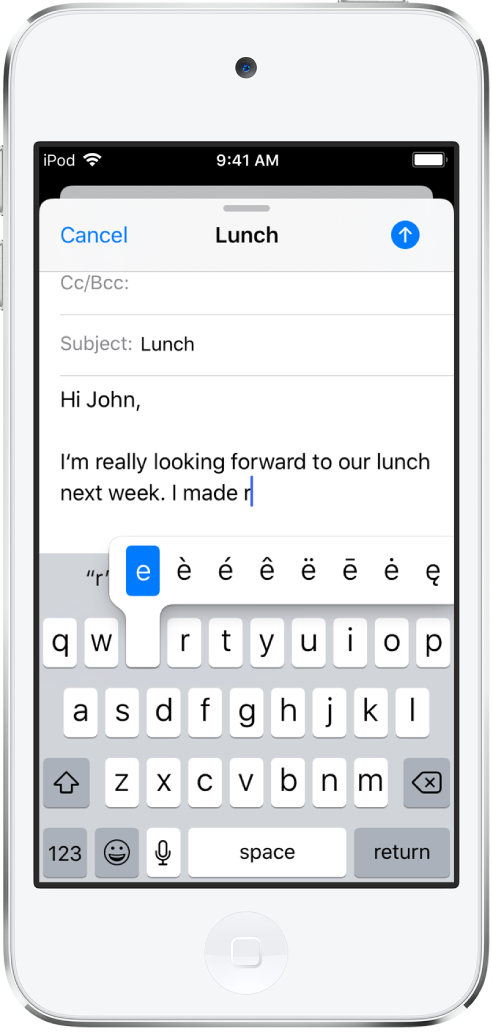iPod touch User Guide
- iPod touch User Guide
- What’s new in iOS 13
- Your iPod touch
-
- Wake and unlock
- Learn basic gestures
- Adjust the volume
- Change or turn off the sounds
- Access features from the Lock screen
- Open apps on the Home screen
- Take a screenshot or screen recording
- Change or lock the screen orientation
- Change the wallpaper
- Search with iPod touch
- Use AirDrop to send items
- Perform quick actions
- Use and customize Control Center
- View and organize Today View
- Charge and monitor the battery
- Learn the meaning of the status icons
- Travel with iPod touch
-
- Calculator
-
- View photos and videos
- Edit photos and videos
- Edit Live Photos
- Organize photos in albums
- Search in Photos
- Share photos and videos
- View Memories
- Find people in Photos
- Browse photos by location
- Use iCloud Photos
- Share photos with iCloud Shared Albums
- Use My Photo Stream
- Import photos and videos
- Print photos
- Shortcuts
- Stocks
- Tips
- Weather
-
-
- Restart iPod touch
- Force restart iPod touch
- Update iOS
- Back up iPod touch
- Return iPod touch settings to their defaults
- Restore all content from a backup
- Restore purchased and deleted items
- Sell or give away your iPod touch
- Erase all content and settings
- Restore iPod touch to factory settings
- Install or remove configuration profiles
-
- Get started with accessibility features
-
-
- Turn on and practice VoiceOver
- Change your VoiceOver settings
- Learn VoiceOver gestures
- Operate iPod touch using VoiceOver gestures
- Control VoiceOver using the rotor
- Use the onscreen keyboard
- Write with your finger
- Use VoiceOver with Magic Keyboard
- Type onscreen braille using VoiceOver
- Use a braille display
- Customize gestures and keyboard shortcuts
- Use VoiceOver with a pointer device
- Use VoiceOver in apps
- Zoom
- Magnifier
- Display & Text Size
- Motion
- Spoken Content
- Audio Descriptions
-
- Copyright
Use international keyboards on iPod touch
With international keyboards you can type text in many different languages, including Asian languages and languages written from right to left. For a list of supported keyboards, go to Apple’s iPod touch website, then scroll to Languages.
Manage keyboards in Settings
Go to Settings
 > General > Keyboard.
> General > Keyboard.Tap Keyboards, then do any of the following:
Add a keyboard: Tap Add New Keyboard, then choose a keyboard from the list. Repeat to add more keyboards.
Remove a keyboard: Tap Edit, tap
 next to the keyboard you want to remove, tap Delete, then tap Done.
next to the keyboard you want to remove, tap Delete, then tap Done.Edit your keyboard list: Tap Edit, drag
 next to a keyboard to a new place in the list, then tap Done.
next to a keyboard to a new place in the list, then tap Done.
If you add an international keyboard, the corresponding language is automatically added to the Preferred Language Order list. You can view this list and add languages directly to it in Settings > General > Language & Region. You can also reorder the list to change how apps and websites display text.
If you’ve added keyboards in other languages, you can type in two languages without having to switch between keyboards. Your keyboard automatically switches between the two languages you type in most often. (Not available for all languages.)
Switch keyboards while typing
While typing text, touch and hold
 on the keyboard.
on the keyboard.Tap the name of the keyboard you want to switch to.
You can also tap ![]() to switch from one keyboard to another. Continue tapping to access other enabled keyboards.
to switch from one keyboard to another. Continue tapping to access other enabled keyboards.
Enter accented letters or other characters while typing
While typing, touch and hold the letter, number, or symbol on the keyboard that’s related to the character you want.
For example, to enter é, touch and hold the e key, then slide to choose a variant.

You can also do any of the following:
On a Thai keyboard: To choose native numbers, touch and hold the related Arabic number.
On a Chinese, Japanese, or Arabic keyboard: Tap a suggested character or candidate at the top of the keyboard to enter it, or swipe left to see more candidates.
Note: To view the full candidate list, tap the up arrow on the right. To return to the short list, tap the down arrow.
Create a text replacement
When using certain Chinese or Japanese keyboards, you can create a text replacement for word and input pairs. The text replacement is added to your personal dictionary. When you type a text shortcut while using a supported keyboard, the paired word or input is substituted for the typed shortcut.
Shortcuts are available for the following:
Simplified Chinese: Pinyin
Traditional Chinese: Pinyin and Zhuyin
Japanese: Romaji and Kana
Go to Settings
 > General > Keyboard.
> General > Keyboard.Tap Text Replacement.
Tap
 at the top right.
at the top right.Type a word or input in the Phrase field and the text shortcut you want to use for it in the Shortcut field.
Reset your personal dictionary
Go to Settings
 > General > Reset.
> General > Reset.Tap Reset Keyboard Dictionary.
All custom words and shortcuts are deleted, and the keyboard dictionary returns to its default state.